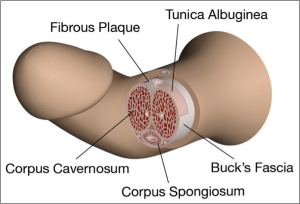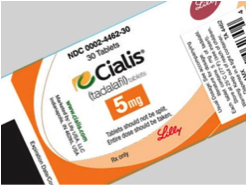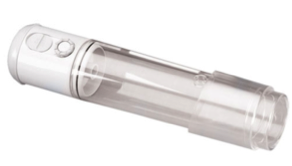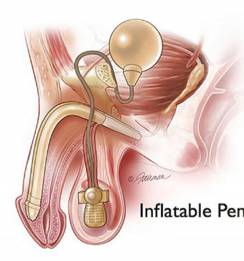Peyronie’s disease is an acquired inflammatory condition of the penis where a plaque (scar) develops under the skin of the penis leading to curvature, painful erections, and erectile dysfunction. The plaque consists of scar tissue that forms within the wall of the tissue called the tunica albuginea that surrounds the corpus cavernosum, which is the structure that fills with blood to create erections. When the plaque is large enough, it causes curvature of the penis that may be painful and may prevent intercourse. Also, the plaque may cause erections to be less rigid or difficult to maintain. Peyronie’s disease is common and may run in families, with an estimated 1% of all men having some degree of Peyronie’s disease.

The exact cause of Peyronie’s disease is unknown, but it is likely that a genetic predisposition to abnormal scar tissue formation is an underlying cause. In some men, Peyronie’s disease is caused by trauma to the penis, for example, sudden and painful bending during intercourse.. Peyronie’s disease can be associated with abnormal scar tissue formation in the plantar fascia of the foot (Ledderhose’s disease), the eardrum (tympanosclerosis), or the palm of the hand (Dupuytren’s contracture). Low testosterone, or hypogonadism, is also commonly seen in men with Peyronie’s disease, which may predispose to poor wound healing and inflammation.
Symptoms and diagnosis of Peyronie’s Disease
Peyronie’s disease often begins with the sudden onset of curvature to the erect penis, which may be initially painful. Peyronie’s disease may present with the new onset of erectile dysfunction. You or your doctor may notice an abnormal hardening or calcification of the tissue below the skin along the shaft of your penis. The plaque commonly occurs on the upper side of the penis near the base, but can also form on the bottom or side of the penis. In some men, the plaque occurs around the entire penis. The condition is usually asymptomatic in the flaccid state.
During erection, there may be:
- A bend in the penis
- Penile pain from the erection or pain during intercourse
- Pain with intercourse for the sexual partner
- Difficulty with penetration
- Shortening of the penis
- Inability to maintain the erection
- Narrowing of a portion of the penile shaft, which is called an “hourglass deformity”
Ultrasound can be used to evaluate the size of the plaque, the degree of penile curvature and severity of associated erectile dysfunction. To perform this ultrasound study, medicine is injected into the penis to produce an erection (see attached). A painless ultrasound probe is used to determine the plaque volume, degree of curvature, arterial blood flow into the penis, and the ability of the veins to keep this blood from exiting the penis. This information is used to develop an individualized treatment plan.
Treatments for Peyronie’s Disease
A combination of oral medications and/or penile injections may improve the symptoms Peyronie’s Disease. A vacuum erection device (VED) may be beneficial to improve penile length or aid with erections if venous leak erectile dysfunction is detected on ultrasound. For a small percentage of men, the curvature can improve over time with or without treatment.
Oral Medications:
The following medications may alleviate some symptoms or slow the progression of Peyronie’s disease:
- Trental (pentoxifylline)
- L-Arginine
- Vitamin E
- Daily phosphodiesterase inhibitor (e.g., Viagra®/Cialis®)
Penile Injections:
Injections of medication directly into the penile plaque are an option that may benefit some men. Traditional intralesional injection therapies include verapamil and interferon. Xiaflex®, an intralesional injection therapy made from collagenase clostridium histolyticum, offers certain men a potential decrease in curvature and symptoms with a simple office procedure. Xiaflex® is an option for men with stable Peyronie’s disease, intact erectile function, and a curvature between 30 and 90 degrees. Xiaflex® consists of a series of one to four 2-day injection cycles in combination with modeling therapy (bending) by the clinician.
Surgical Repair:
Surgical treatment is typically reserved for men with a severe penile curvature or erectile dysfunction that prevents intercourse. The main goal of surgery is to straighten the penis enough to restore satisfactory sexual function.
Surgical procedures for men with severe curvature but preserved erection function may include:
- Plication: This procedure involves placement of nonabsorbable sutures into the tissues of the penis opposite the curve. Although it causes some shortening of the erect penis, it has the lowest risk of subsequent erectile dysfunction.
- Incision and grafting: In this procedure, the Peyronie’s plaque is incised and replaced with a graft.
Penile Prosthesis:
For men with Peyronie’s disease and erectile dysfunction not responsive to conservative treatment options, implantation of a penile prosthesis is the best option. A penile prosthesis completely cures the disorder by restoring sexual function, a straight penis, and one’s confidence. Performed through a small hidden penoscrotal incision, a penile implant is invisible in your body while producing a completely natural erection and sexual experience. Sensation, orgasm, ejaculation, and urination are unaffected. The prosthesis has the highest success rate of all the treatments for Peyronie’s disease and erectile dysfunction, and over 90% of men and their partners have reported satisfaction after the procedure. There are two main types of penile prosthesis: inflatable and malleable. An inflatable penile prosthesis consists of 3 components that allows for a normal flaccid state, and then inflation through a scrotal pump produces a rigid state. A malleable penile prosthesis exists in a permanent semirigid state that bends downwards for dressing and bends upwards for sexual activity.









 scarring. Daily Cialis® (tadalafil) is very effective in preserving erectile function. Two weeks prior to surgery you will be asked to start taking 5mg of Cialis® every day. In one
scarring. Daily Cialis® (tadalafil) is very effective in preserving erectile function. Two weeks prior to surgery you will be asked to start taking 5mg of Cialis® every day. In one vacuum erection device (VED) on a daily basis to help increase blood flow and oxygen to the penis. The use of a vacuum erection device (VED) on a daily basis has been shown to increase blood flow and oxygen to the penis as well as preserve penile length.
vacuum erection device (VED) on a daily basis to help increase blood flow and oxygen to the penis. The use of a vacuum erection device (VED) on a daily basis has been shown to increase blood flow and oxygen to the penis as well as preserve penile length. injection therapy. This involves inserting a small needle into the side of the penis and injecting a medication that increases the blood flow into the penis.
injection therapy. This involves inserting a small needle into the side of the penis and injecting a medication that increases the blood flow into the penis.